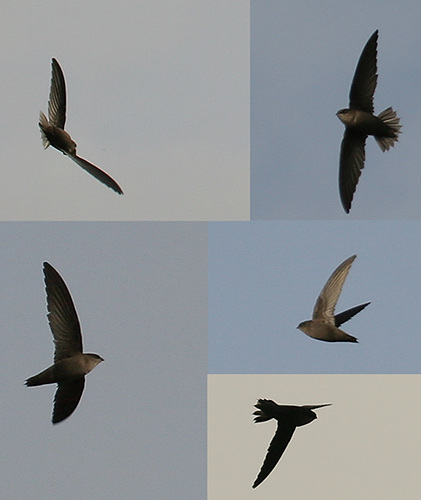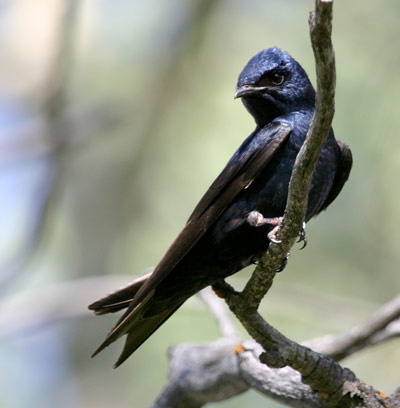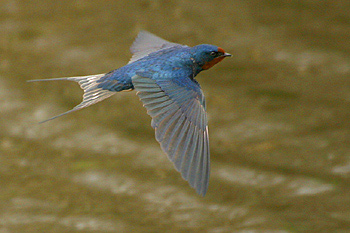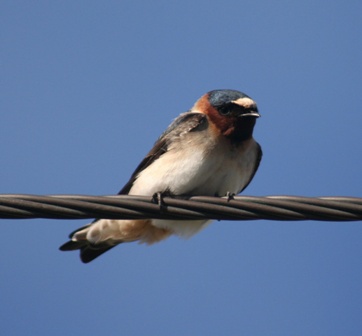You guys rock! I've been coming here for weeks identifying the birds in our backyard for my daughter's school project. Thanks so much for this valuable resource.

Small cigar-shaped body - flies fast and high over urban areas or low over lakes and rivers. Brown body. Twittering call.
In flight, this bird looks like a flying cigar with long slender curved wings. The plumage is a sooty grey-brown; the throat, breast, underwings and rump are paler. They have short tails.
Their breeding habitat is near towns and cities across eastern North America. Originally, these birds nested in large hollow trees, but now they mainly nest in man-made structures such as large open chimneys. The nest is made of twigs glued together with saliva and placed in a shaded location.
They are long distance migrants and winter in eastern Peru; other nesting locations in South America may exist. They migrate in flocks. This species has occurred as a very rare vagrant to western Europe. the gregarious nature of this species is reflected in that two individuals of this species turned up together on the Isles of Scilly in the UK
These birds live on the wing, foraging in flight. They eat flying insects.
Their population may have increased with the availability of large chimneys as nesting locations. With suitable man-made habitat becoming less common, their numbers may be declining in some areas.
Photo © Quelennec Thierry

Large swallow. Nests communally. See how to attract Purple Martins
Adult males are a glossy dark purple, and adult females are dark on top with some purple on the back, and lighter underparts. Juveniles are greyish-brown above and whitish below, gaining some purple feathers by their first winter.
Their breeding habitat is open areas across eastern North America, and also some locations on the west coast from British Columbia to Mexico. This species typically breeds in colonies.
The eastern nominate race nests exclusively in man-made bird houses, of which about a million are provided. It is the only bird totally dependent on humans for nest sites. It is important to note that unmonitored Purple Martin houses often become breeding colonies for House Sparrows and Starlings - invasive species responsible for the decline of the Eastern Bluebird and Red-headed Woodpecker respectively. Purple Martins will not nest in such a site until the House Sparrows and Starlings are removed. In severe infestations, it is best to take down the Purple Martin house or plug the entrance holes.
The paler subspecies P. s. hesperia of Arizona and western Mexico uses only woodpecker holes in Saguaro and other large cacti, and the large pale west coast form P. s. arboricola utilises woodpecker and other natural cavities as well as nesting boxes and gourds.
The Purple Martin migrates to the Amazon basin in winter. The first record of this species in Europe was a single bird on Lewis, Scotland on 5-6 September 2004, and the second was on the Azores on 6 September 2004.
These birds hunt for insects in flight, although sometimes they will pick up insects off the ground. They usually fly relatively high, so, contrary to popular opinion, mosquitos do not form a large part of their diet.
The call is a gurgly tchew-tchew.
Photo © Tim Avery

White below and blue above.
This swallow averages 13.5 cm (5 inches) long and weighs about 20g. The bill is tiny. The adult Tree Swallow has iridescent blue-green upperparts, white underparts, and a very slightly forked tail. The female usually has duller colours than the male, often more greenish than the more bluish male. The juvenile plumage is dull grey-brown above and may have hint of a gray breast band.
Tree Swallows nest in natural or artificial cavities near water and are often found in large flocks. They also readily nest in nest boxes maintained by people, often for Eastern Bluebirds.
The Tree Swallow nest consists of multiple layers of small twigs and grasses and is lined with large feathers. (As such, it is easy to differentiate from that of an Eastern Bluebird.) The female lays 4 to 6 white eggs and incubates them by herself. The eggs hatch in about 14 days and the hatchlings are not precocious and need to be fed by both parents. The hatchlings typically fledge in 16-24 days.
Tree swallows have only one brood in a year.
They subsist primarily on a diet of insects, sometimes supplemented with small quantities of fruit. Tree Swallows are excellent fliers and take off from their perch and acrobatically catch insects in their bills in mid-air.
Photo © Ryan Sayers

white below and blue above but with a red throat.
Barn Swallows are similar in habits to the other aerial insectivores, including the other related swallows and martins and the unrelated swifts (order Apodiformes). They are not particularly fast flyers (estimated at about 11 m/s [1]), but show remarkable manoeuvrability, necessary to feed on flying insects while airborne. They are often seen flying relatively low in open or semi-open areas.
Barn Swallows build neat cup-shaped nests constructed of mud collected in their beaks. The inside of the nest is lined with grasses, feathers and other soft materials. They normally nest in accessible buildings such as stables or under bridges and wharves. Before these types of sites became common, they nested on cliff faces or in caves. The female typically lays 4 or 5 eggs. Both parents build the nest and feed the young.
The numbers in North America increased during the 20th century with the increased availability of man-made nesting sites. In recent years, there has been an ongoing gradual decline in numbers in parts of Europe and North America, due to agricultural intensification reducing the availability of insect food. However, it remains widespread and fairly common in most parts of its range.
Photo © Simon Woolley

Similar to Barn Swallow but has short square tail and reddish rump.
It breeds in North America and Mexico, and is migratory, wintering in southern South America. This species is a very rare vagrant to western Europe.
These birds average 5 inches long with a tiny bill. The adult has an iridiscent blue back and crown, brown wings and tail, and buff rump. The nape and forehead are white. The underparts are white except for a red face. The tail is square-ended.
Young birds are essentially brown above and whitish below, except for the buff rump and dark face.
The only confusion species is the closely related Cave Swallow, which is richer in colour and has a cinnamon rump and forehead.
Cliff Swallows breed in large colonies. They build conical mud nests and lay 3-6 eggs. The natural nest sites are on cliffs, preferably beneath overhangs, but as with the Eurasian House Martin, man-made structures are now the principal locations for breeding. Female Cliff Swallows are known to lay eggs in and move previously laid eggs into the nests of other birds within the colony.
This species has always been plentiful in the west of North America, where there are many natural sites, but the abundance in the east has varied.
European settlement provided many new nest sites on buildings, but the population declined in the late nineteenth and early twentieth centuries as the supply of unpainted barns declined. There has been a subsequent revival as dams and bridges have provided suitable sites. These are the famous swallows that return every year to the Mission San Juan Capistrano in California on (or around) March 19.
Like all swallows and martins, Cliff Swallows subsist primarily on a diet of insects which are caught in flight.
Photo © Alan Henry